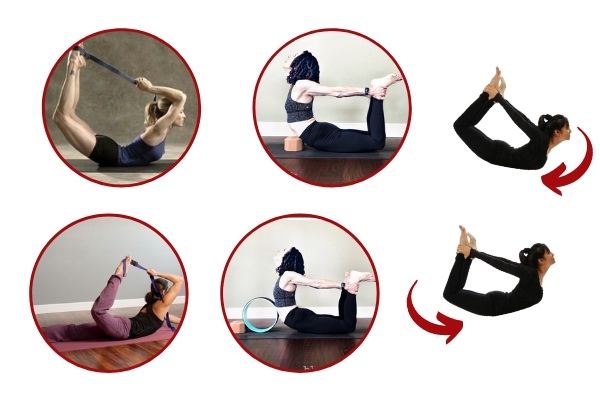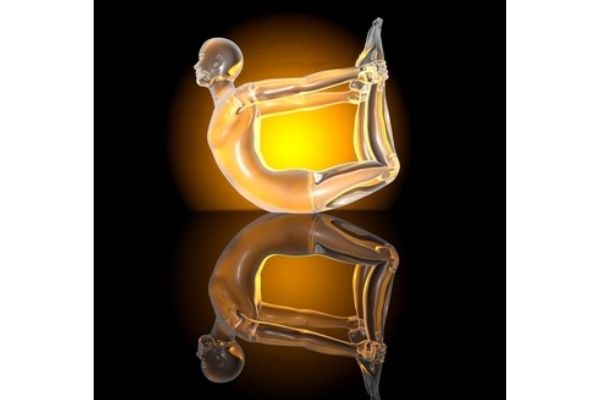Dhanurasana is one asana having multiple health benefits. It is named after the shape that the body takes while practicing this back-bending pose- a bow. And so, it is also known as the bow pose. The name is derived from the Sanskrit word ‘Dhanur’ meaning ‘bow’ and ‘asana’ meaning the ‘pose’. Like a bow with an arrow is an asset to a warrior, an extensively stretched body helps you maintain flexibility and good posture.
Significance of Dhanurasana
Dhanurasana is one of the twelve basic hatha yoga poses, can also be termed as Urdhva Chakrasana. It is one of the significant back stretching exercises in modern yoga, giving powerful stretch to the front of the body, providing a deep chest opening sequence. It helps to open up the heart center, reenergizing the body, and developing a fearless attitude. It is a great pose to stretch and stimulate the whole parts of the body including arms, shoulders, back, core muscles, hamstrings, chest, hips, and neck.

How to do Dhanurasana?
- Make sure your stomach is empty before practicing Dhanurasana. Do it 3-4 hours after having food.
- You can use Shalabhasana or Bhujangsana as the preparatory poses to warm up your body.
- Lie on the ground on your stomach with feet apart, keep your arms on your side.
- Slowly fold your legs, push your hands backward and hold your ankles.
- Breath in and lift your chest and legs off the ground. Pull your legs up and towards the back.
- Look straight ahead, try to hold the pose for few seconds or as long as you feel comfortable.
- Continue to take deep breaths and concentrate on your breath while performing this pose.
- While exhaling release the ankles, slowly bring legs and chest to the ground.
- You can also use a strap if you are a beginner and unable to hold the ankles.
- While exhaling release the ankles, slowly bring legs and chest to the ground.
Variations of Dhanurasana
There are some variations available for Dhanurasana with different levels of complexities. One can perform these variations and can attain the final pose with stabilized breathing pattern over a course of time.

Dhanurasana or Bow pose is an intermediate yoga pose that requires some level of flexibility. You can use straps to hold the legs when unable to reach the ankles. Ek pada dhanurasana, also known as the half-bow pose is performing the dhanurasana with only one leg. This variation also provides an intense stretch to the body but not as intense as that of dhanurasana.

You can also perform Padngushtha Dhanurasana also called as Big toe bow pose. If you find it difficult to hold the ankles then you can hold the toe and perform the big toe bow pose. Once you start gaining the flexibility you can advance to the ankles. Always strive to hold the ankles while performing dhanurasana.
Similarly, at the beginning holding the dhanurasana pose even for 15-20 seconds may seem difficult. One can move forward and backward like a seesaw to make the balance. There are such variations available that can help you to reach the ultimate dhanurasana pose or can also help to advance the practice further complexing it. Consult an expert yoga teacher for variations.

Benefits of Dhanurasana
There are countless benefits of performing dhanurasana or bow pose regularly.
- It stretches the abdomen and organs in it, stimulating the reproductive system.
- It gives an extensive stretch to the complete body, strengthening the back and abdominal muscles, ankles, arms, legs, and groin.
- It opens up the chest, neck, and shoulders.
- It reduces belly fat and tones the legs, arms.
- Helps in alleviating stress and fatigue.
- It improves back flexibility, increases blood circulation throughout the body.
- It aids in digestion, cures menstrual discomfort.
- It is highly remedial in kidney disorders, curing asthma, and improving the functioning of the pancreas (benefiting in diabetes).

Who should not perform Dhanurasana?
People with the following medical conditions should avoid practicing dhanurasana or must consult the medical practitioner or doctor before starting the practice-
- Having high or low blood pressure issues
- Hernia
- Recent abdominal surgery
- Neck injury
- Low back pain
- Spondylitis
- Headache or migraine
- Pregnant women
Dhanurasana has a collective health benefit that improves your physical wellbeing to a great extent. Though it is a complex asana, it becomes easier with regular practice and time. Avoid performing it at home without any guidance if you are a complete beginner in yoga. To know more about the Dhanurasana steps and benefits consult Shwet Yoga Wellness Institute, Thane.
